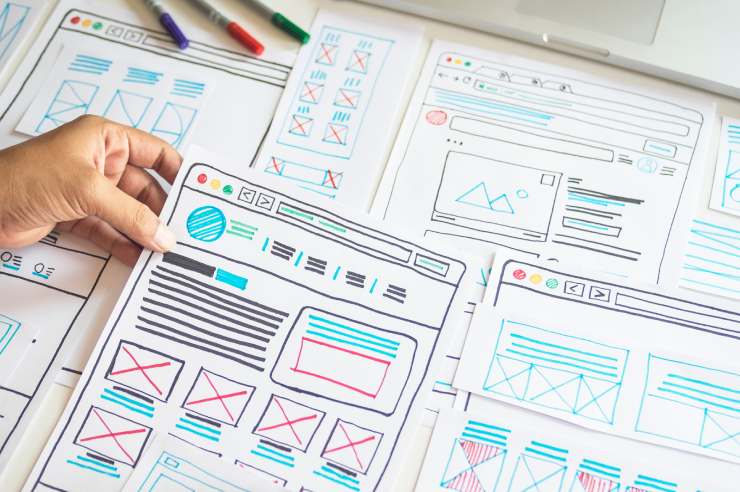Maintaining a strong online presence is critical for success in the digital marketing world. That’s where the debate of website refresh vs. redesign comes into play. So, how do you decide whether your site needs a simple refresh or a complete overhaul? Let’s dive into the key differences, costs, and factors to consider when making this critical decision.
Understanding the Differences Between Website Refresh and Redesign
When it comes to updating your website, it’s essential to know the difference between a website refresh vs. redesign.
What is a Website Refresh?
Think of a website refresh as a rejuvenating treatment for your online home. It’s a delicate process that focuses on enhancing the aesthetic aspects of your site without making drastic structural or functional changes. Website refreshes are the perfect solution for businesses seeking to invigorate their online presence without committing to a complete transformation.
Key components of a website refresh include:
Color Palette Evolution: Introducing new colors or updating your current palette can create a fresh and modern look for your site, reflecting your brand’s personality and setting the tone for your visitors’ experience.
Font Facelift: Updating your typography can significantly impact the overall appearance and readability of your website. Exploring new fonts and font combinations can help convey your brand message more effectively and make your content more enjoyable.
Imagery Update: Replacing outdated or generic images with high-quality, relevant visuals can instantly elevate your website’s appeal. Carefully chosen images can evoke emotions and connect with your audience, drawing them further into your brand story.
Streamlined Navigation: While not a significant structural change, simplifying and organizing your site’s navigation can make it easier for users to find the information they’re looking for, enhancing their overall experience on your site.
Content Optimization: Reviewing and updating your site’s content can make it more engaging, relevant, and valuable to your audience. This may include fixing broken links, removing outdated information, and optimizing your content for search engines.
A website refresh is ideal for businesses that want to keep their online presence up-to-date and engaging without investing in a full-scale redesign. By focusing on these key aspects, you can give your website the revitalizing boost it needs to impress and retain your audience.
What is a Website Redesign?
A website redesign can be likened to a metamorphosis, where your online home undergoes a complete visual and functional transformation. This comprehensive process involves rethinking the site’s architecture, enhancing its performance, and optimizing the overall user experience. A website redesign is an excellent solution for businesses seeking to shift their online strategy or tackle significant usability challenges.
Key aspects of a website redesign include:
Rethinking Site Architecture: By evaluating and restructuring your website’s layout and organization, you can create a more intuitive user experience. This may involve reorganizing content, introducing new categories, or simplifying your site’s navigation.
Enhanced Functionality: Upgrading your site’s features or incorporating new technologies can significantly improve its performance and user experience. This may include adding e-commerce capabilities, implementing chatbots, or optimizing the site for mobile devices.
Revamped User Experience: A website redesign aims to create a seamless and enjoyable experience for visitors. This involves carefully considering user feedback, analyzing site metrics, and adjusting to enhance usability and accessibility.

Content Overhaul: A redesign offers the opportunity to reassess your site’s content strategy and align it with your business goals. This may involve creating new content, optimizing existing content for SEO, and addressing any content gaps or redundancies.
Visual Refresh: While a website redesign goes beyond aesthetics, updating the visual elements is still a crucial aspect of the process. This may include embracing modern design trends, refining your color palette, and choosing fonts that reflect your brand identity.
A website redesign is an excellent option for businesses seeking to make significant changes to their online presence, whether to accommodate a new business direction or address critical usability issues. By focusing on these key aspects, your website can emerge from its transformation as a more effective, engaging, and user-friendly online home for your brand.
How Often Should You Refresh or Redesign Your Website?
The frequency of updating your website depends on a variety of factors.
Factors Influencing Website Refresh Frequency
Determining the right moment to refresh your website is crucial to maintain its relevance and appeal. By closely monitoring various factors and best practices, you can ensure that your website remains up-to-date and continues to engage your target audience effectively.
Consider the following aspects when deciding how often to refresh your website:
Industry Trends and Design Standards: Just as fashion evolves, so do web design trends and standards. Regularly monitoring industry developments can help you identify when your site may benefit from an update. Pay attention to popular design elements, usability trends, and emerging technologies to stay ahead of the curve.
Changes in Branding or Marketing Strategy: Your website should always reflect your brand’s identity and marketing objectives. If your company undergoes a rebranding or shifts its marketing strategy, it’s essential to update your site accordingly. This may involve adjusting the color scheme, updating imagery, or even repositioning your site’s focus to align with your new goals.
User Feedback and Analytics Data: Your website’s users can provide invaluable insights into its performance and areas for improvement. Regularly review user feedback, and analyze your site’s analytics data to identify potential issues or opportunities for enhancement. Metrics such as bounce rate, time spent on site, and conversion rates can help you pinpoint areas that may benefit from a refresh.
Schedule Periodic Evaluations: To maintain your site’s relevance and effectiveness, evaluating it for a potential refresh every 12 to 18 months is a good idea. This ensures that you stay attuned to the latest trends, address any emerging issues, and continue to deliver a satisfying user experience.
By considering these factors and regularly evaluating your site’s performance, you can develop an effective refresh strategy that keeps your online presence fresh, engaging, and in tune with your brand’s goals. Staying proactive with website updates ensures that your site remains a valuable asset in your digital marketing toolkit.
Factors Influencing Website Redesign Frequency
Deciding when to undertake a complete website redesign can be a critical decision for your business. By carefully considering various factors and adhering to best practices, you can ensure your website redesign is well-timed and optimally effective.
Keep the following aspects in mind when determining the frequency of your website redesign:
Significant Changes in Business Model or Target Audience: If your business undergoes a major transformation or shifts its focus to a new target audience, a website redesign may be necessary to reflect these changes. An updated site architecture and design can help you better cater to your new audience’s preferences and showcase your revised business offerings.

Advances in Technology or Web Design Principles: The digital landscape is constantly evolving, and your website should keep pace with these changes. Stay informed about new technologies, tools, or design principles that can improve your site’s performance, user experience, or accessibility. A redesign can help you take advantage of these advancements and maintain a competitive edge in your industry.
Poor Website Performance or User Experience Issues: A complete redesign may be the best solution if your site consistently underperforms or suffers from significant user experience issues. Addressing fundamental problems with your site’s architecture, functionality, or layout can dramatically improve user engagement, conversion rates, and search engine rankings.
Set a Redesign Schedule: As a general rule of thumb, consider a full website redesign every 3 to 5 years. This timeframe allows you to adapt to the rapidly changing digital landscape while maintaining a fresh and modern site that meets users’ evolving expectations.
By considering these factors and staying attuned to your site’s performance, you can develop a well-timed website redesign strategy that sets your business up for long-term success. A thoughtfully planned and executed redesign can profoundly impact your online presence, helping you achieve your goals and maintain a competitive edge in today’s digital market.
Website Refresh Examples and Benefits
Refreshing your website can yield significant benefits and help keep your online presence fresh and engaging.
Top Website Refresh Examples
A well-executed website refresh can significantly impact your site’s overall user experience, engagement, and performance. Here are three notable examples of businesses that successfully updated their websites with a refresh:
Airbnb: In an effort to improve user experience and reinforce its brand identity, Airbnb updated its site’s visuals by introducing a cohesive color palette, typography, and illustrations. These changes enhanced the aesthetic appeal of the site and made it easier for users to navigate and find relevant information. The refresh helped Airbnb maintain its strong online presence and reinforce its position as a leading platform in the travel industry.
Mailchimp: Known for its user-friendly email marketing platform, Mailchimp sought to optimize its calls-to-action (CTAs) through a website refresh. By streamlining their CTAs and making them more prominent, Mailchimp encouraged users to take desired actions, such as signing up or exploring features. The refresh improved user engagement and contributed to higher conversion rates.
Starbucks: As a global brand with a massive mobile user base, Starbucks recognized the importance of mobile responsiveness. Through a website refresh, Starbucks improved its site’s mobile experience by implementing a responsive design and reorganizing content to better suit mobile devices. This update allowed Starbucks to deliver a seamless user experience across all devices, enhancing customer satisfaction and brand loyalty.
These successful website refresh examples demonstrate how updating visual elements, optimizing CTAs, and improving mobile responsiveness can substantially impact a site’s performance and user experience. By learning from these case studies and applying similar principles to your own website, you can achieve similar results and set your online presence up for long-term success.
Website Redesign Examples and Benefits
A complete website redesign can lead to even more significant improvements in your online presence.
Top Website Redesign Examples
Let’s explore some real-life examples of successful website redesigns that demonstrate the transformative impact of overhauling a site’s architecture, implementing new features, and addressing major accessibility or usability concerns:
Apple: Apple’s website redesign focused on improving site architecture by creating a more intuitive navigation menu and categorizing products by their type. This streamlined approach made it easier for users to find what they were looking for and provided a more enjoyable browsing experience. The redesign also emphasized Apple’s minimalistic design aesthetic, showcasing its commitment to both form and function.
HubSpot: HubSpot, a leading marketing and sales software provider, redesigned its website with a focus on implementing new features and functionality. They introduced a more dynamic homepage, interactive content, and an improved resource library to better cater to their diverse user base. These enhancements provided a more engaging user experience and showcased HubSpot’s expertise in the marketing and sales industry.
Slack: The popular team collaboration and messaging platform, Slack, decided to undertake a significant website redesign to improve its overall user experience. The company focused on simplifying navigation, making it easier for new and existing users to discover and access essential features. They also introduced a more vibrant and engaging color palette, reinforcing their brand identity as a modern and innovative tool for workplace communication. The redesign has helped Slack maintain its competitive edge and continue to attract businesses of all sizes.
These real-life examples of website redesigns highlight the potential benefits of investing in a comprehensive overhaul of your site. By addressing architecture, functionality, accessibility, and usability concerns, these companies successfully transformed their online presence and created a more engaging, user-friendly experience for their audiences. Embracing a redesign can set your website up for long-term success and help you stand out in today’s competitive digital landscape.
The Costs of a Website Refresh vs. Redesign
When deciding between a website refresh vs. redesign, it’s crucial to consider the costs involved in each approach.
Website Refresh Costs: What to Expect
A website refresh, though more affordable than a redesign, still involves some expenses. Here’s a more detailed breakdown of what to expect in terms of costs:
New visual elements: Refreshing your site often includes investing in new images, fonts, and other visual components to create a more modern and appealing look. These costs can range from purchasing stock images or hiring a photographer to sourcing premium fonts or commissioning custom illustrations.
Design and development time: Depending on the scope of the refresh, you may need to allocate funds for the time spent by your internal team or external designers and developers. This could include updating your site’s CSS, tweaking page layouts, and optimizing images for faster load times. 
Third-party tools and plugins: If your refresh involves integrating new tools or updating existing ones, such as social media widgets, analytics tracking, or email marketing integrations, there may be associated costs for these services.
Ongoing maintenance and updates: To keep your site looking fresh and relevant, you’ll want to budget for regular maintenance and updates. This could include periodically updating content, addressing minor design issues, or resolving any technical problems that arise.
While a website refresh is generally more affordable than a complete redesign, it’s essential to account for the various costs involved. By planning for these expenses, you can maintain your site’s relevance and user experience without breaking the bank.
Website Redesign Costs: What to Expect
A website redesign typically requires a more significant investment compared to a refresh. However, the long-term benefits often justify the costs. Here’s a breakdown of what to expect when budgeting for a website redesign:
- Web design agency or freelancer fees: A redesign often involves hiring a web design agency or a freelancer to handle the project. Their fees will depend on the scope of work, expertise, and the complexity of your site. Make sure to account for their services when budgeting for your redesign.
- Custom development work: A website redesign may require custom development to add new features, integrate third-party services, or improve overall site performance. This could involve hiring developers to create custom code or modify existing systems.
- New software or plugins: You may need to purchase new software or plugins to enhance your site’s functionality and user experience. This could include content management systems (CMS), e-commerce platforms, or SEO optimization tools.
- Content creation and optimization: A redesign often includes reorganizing and updating your site’s content. This might involve hiring copywriters or editors to create new, engaging content or to optimize existing content for SEO purposes.
- User experience and accessibility testing: Ensuring your redesigned site is user-friendly and accessible is crucial. You may need to budget for user experience (UX) designers, user testing, or accessibility audits to guarantee your site meets the needs of your audience.
- Ongoing maintenance and updates: After your redesign, it’s essential to plan for regular maintenance, updates, and potential improvements. This includes addressing technical issues, updating content, and staying on top of design trends.
By considering these costs when budgeting for a website redesign, you can make a more informed decision about whether it’s the right move for your online presence. Remember, the long-term benefits of a redesign, such as improved user experience and increased conversions, can outweigh the initial investment.
Deciding Whether to Refresh or Redesign Your Website
To determine the best approach for your site, consider these factors for website refresh vs. redesign:
Evaluating Your Current Website Performance
Analyze your site’s performance by looking at metrics like bounce rates, conversion rates, and user engagement. Regularly monitoring these key performance indicators (KPIs) will help you identify areas that need improvement. If your site is underperforming, a redesign might be necessary to address the underlying issues and boost your online success.
Identifying Your Website Goals and Objectives
Consider your site’s objectives, such as lead generation, sales, or brand awareness. If your current website isn’t meeting these goals or if they have changed significantly, a redesign may be the best option. Regularly reviewing and updating your website goals ensures that your online presence remains aligned with your business strategy and priorities.
Assessing Your Budget and Resources
Take a realistic look at your budget and the resources available to invest in updating your website. If you have limited funds or time, a website refresh may be more feasible, while a larger budget might allow for a comprehensive redesign. Additionally, consider any potential return on investment and how the costs of each approach align with your long-term business goals and growth plans.
Making the Right Decision for Your Website’s Future
In the website refresh vs. redesign debate, the best choice depends on your site’s current performance, goals, and available resources. By carefully evaluating these factors and the potential benefits and costs of each approach, you can make an informed decision that will set your site up for long-term success. Remember, maintaining a modern and engaging online presence is essential in today’s digital landscape, so invest wisely in your website’s future. If you’re interested in getting a quote for a website refresh or redesign, reach out to Oyova today to hear more about our website development services.
